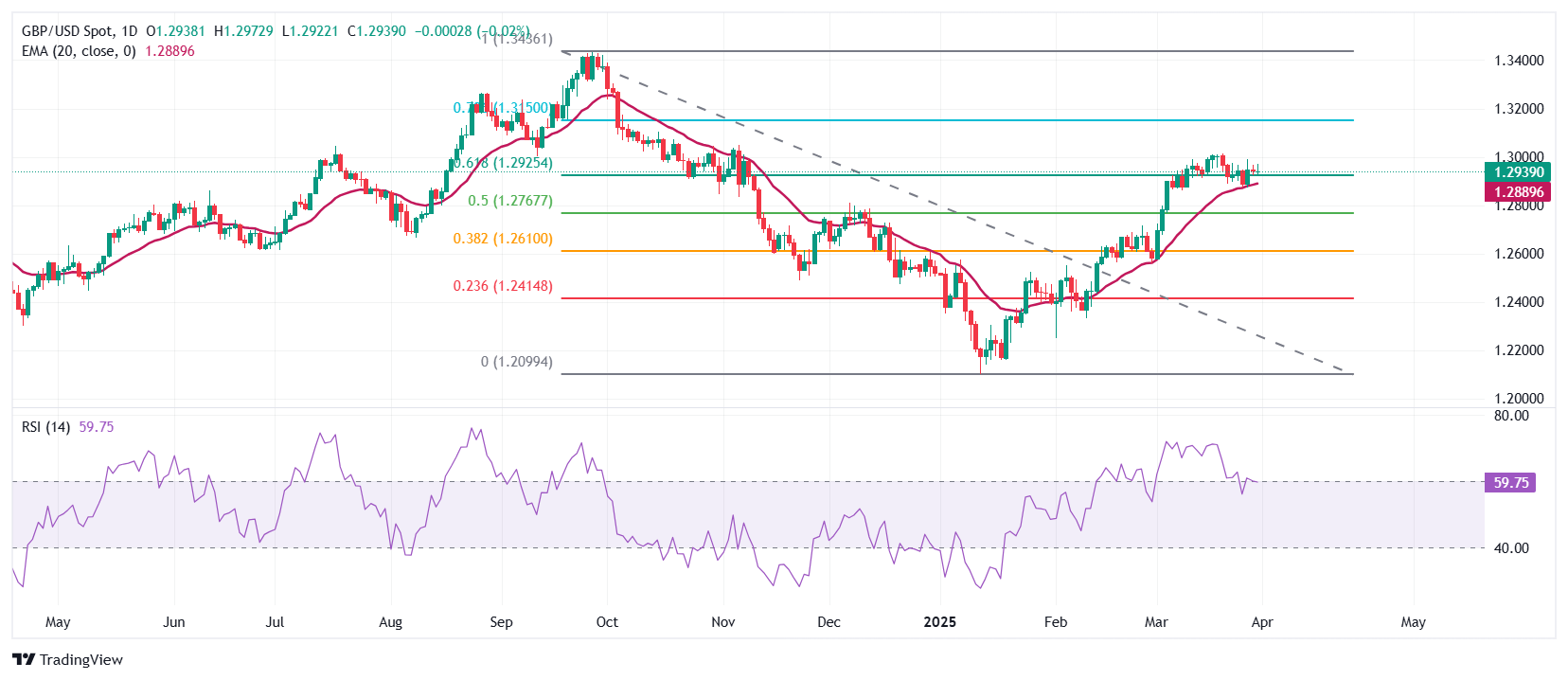-
The Pound Sterling hovers around 1.2940 against the US Dollar as investors anticipate Trump’s reciprocal tariff announcement on Wednesday.
-
Goldman Sachs warns of increased US recession risks due to tariff concerns.
-
The Bank of England is expected to adopt a moderate monetary expansion cycle this year.
The Pound Sterling (GBP) starts the week on a stronger note against its major counterparts, except for the Japanese Yen (JPY), which benefits from safe-haven demand amid concerns over U.S. President Donald Trump’s upcoming reciprocal tariff announcement on "Liberation Day" this Wednesday. Investors remain optimistic that Trump's tariffs will have minimal impact on the United Kingdom’s (UK) economic outlook.
On Thursday, UK Chancellor of the Exchequer Rachel Reeves told Bloomberg Television that intense negotiations are underway to secure a “good deal for Britain.” Market optimism is further supported by Trump’s February remarks, where he expressed uncertainty about imposing tariffs on the UK and suggested that an agreement was possible, praising Prime Minister Keir Starmer as “very nice.”
Adding to the Pound Sterling’s strength, upbeat UK Retail Sales data for February surprised markets. The Office for National Statistics (ONS) reported a 1% month-on-month increase, defying expectations of a 0.3% decline and signaling resilience in consumer spending.
Meanwhile, expectations of a moderate monetary easing cycle by the Bank of England (BoE) have also supported GBP. The BoE, which has already cut interest rates once in 2025, is anticipated to reduce borrowing costs only two more times this year, keeping the Pound Sterling well-supported.
Daily Market Movers Digest: Pound Sterling Holds Steady Against US Dollar
- The Pound Sterling (GBP) remains rangebound against the US Dollar (USD), hovering around 1.2940 during Monday’s North American session. The GBP/USD pair trades flat as investors remain cautious ahead of former U.S. President Donald Trump’s reciprocal tariff announcement on Wednesday.
- Market participants expect Trump’s proposed tariffs to have a significant impact on global economic growth. Higher duties on select goods could reduce their competitiveness, forcing companies to lower prices and redirect exports to alternative markets.
- Analysts at Barclays predict that countries with large trade deficits with the U.S. and high existing tariff or non-tariff barriers will be prime targets for reciprocal levies. This includes the European Union (EU), China, Canada, India, and Japan—all of which could face increased U.S. tariffs.
- Financial markets also see heightened economic risks for the U.S. due to Trump’s trade policies. Goldman Sachs has raised its U.S. recession probability from 20% to 35%, citing deteriorating business and consumer confidence. White House officials have also signaled a greater tolerance for near-term economic weakness in pursuit of long-term policy goals.
- Meanwhile, investors are closely watching key U.S. economic data this week, including the ISM Manufacturing and Services PMI reports and labor market indicators, which will shape expectations for the Federal Reserve’s (Fed) monetary policy stance.
Technical Analysis: Pound Sterling Holds Above 1.2900

GBP/USD continues to fluctuate around the 61.8% Fibonacci retracement level from the late-September high to the mid-January low, near 1.2930. The 20-day Exponential Moving Average (EMA) remains a key support level at 1.2890.
The 14-day Relative Strength Index (RSI) has cooled to 60.00 after previously reaching overbought levels above 70.00. A resurgence in bullish momentum could occur if the RSI stabilizes above 60.00 and resumes its upward movement.
-
Support levels: 50% Fibonacci retracement at 1.2770 and 38.2% Fibonacci retracement at 1.2610
-
Resistance level: October 15 high at 1.3100





